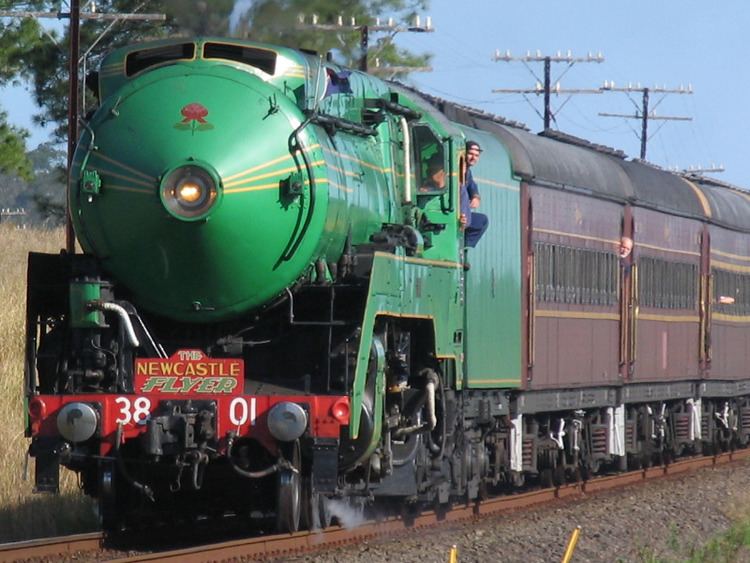Power type Steam | Build date 1943–49 Driver dia. 5 ft 9 in (1,750 mm) | |
 | ||
Gauge 4 ft 8 ⁄2 in (1,435 mm) | ||
The C38 class was a class of steam locomotives built for the New South Wales Government Railways in Australia.
Contents
Built between January 1943 and November 1949, the 30 locomotives in the class were designed to haul express trains. They were the only New South Wales locomotives to use the popular Pacific 4-6-2 wheel arrangement and were the last steam locomotives built for passenger train operation, all subsequent deliveries being specifically for freight haulage.
Design
The 38 class were first conceived in the 1930s being heavily influenced by American and other streamlined locomotives of the time. The NSWGR needed a locomotive to eliminate the complications of doubleheading required on a number of fast interstate passenger trains.
The design team was headed by Harold Young, the Chief Mechanical Engineer of the NSWGR. The conditions of trackwork with frequent sharp curvature to be traversed at high speed would require six-coupled driving wheels in a 'Pacific' 4-6-2 configuration. Maintenance considerations suggested a two-cylinder simple steam locomotive.
The design was carried out by the NSWGR Locomotive Section of the Design Office and incorporated the latest developments in locomotive design from Australia and overseas. The incorporation of as many Australian manufactured components as possible was a requirement at the design stage.
History
In May 1939 an order for five 38 class locomotives was placed with Clyde Engineering. They suffered many delays during construction, mostly due to resource shortages caused by World War II. The first five locomotives were built by Clyde Engineering and had distinctive streamlined boiler casing. The remaining 25 locomotives were built at the New South Wales Government Railways' Eveleigh Railway Workshops (13 even number locomotives) and Cardiff Locomotive Workshops (12 odd numbered locomotives).
The Clyde Engineering built examples were delivered in wartime grey. Following the cessation of the war, all were repainted green as were the 25 unstreamlined locomotives from new. All except 3813 were repainted black in the 1950s.
Among the services they initially hauled were the Central West Express, Newcastle Flyer, Melbourne Limited, Riverina Express and South Coast Daylight Express as well as the overnight mail trains. Because of their axleload they were confined to operating between Port Kembla, Albury, Dubbo and Maitland.
Following the arrival of the 42, 43 and 44 diesel locomotives in the 1950s, these began to take over but the 38 class continued to haul many. After the electrification of the Main Western line to Lithgow in 1957 and the Main North line to Gosford in January 1960 the 46 class electrics took over but the 38s still operated the Central West Express between Lithgow and Orange into the 1960s and the Newcastle Flyer between Gosford and Newcastle until December 1970.
They also began to haul lesser passenger and freight trains. In April 1962 3830 and 3813 hauled the inaugural standard gauge Spirit of Progress from Albury to Sydney. The first was withdrawn in 1961 with the last withdrawn in December 1970.
In August 1970, 3801 hauled the Western Endeavour to Perth following the completion of the standard gauge Trans-Australian Railway with 3813 assisting as far as Port Pirie. In April 1988, 3801 again operated to Perth during the Australian Bicentenary.
3801 featured in the 1974 short film A Steam Train Passes.
